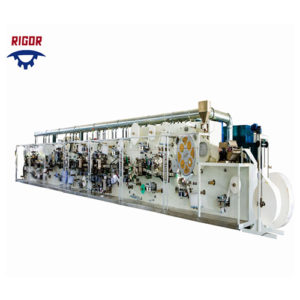Maintenance schedules for machinery, including sanitary napkin manufacturing machines, are crucial for minimizing downtime and ensuring continuous and reliable operation.
Here’s a general overview of how maintenance schedules are planned to achieve these objectives:
- Manufacturer Guidelines:
- Manufacturers of machinery provide detailed guidelines and recommendations for maintenance. These guidelines often include schedules for routine inspections, lubrication, and replacement of consumable parts.
- Equipment Manuals:
- Machinery comes with manuals that outline maintenance procedures, recommended intervals for specific tasks, and a list of critical components that require attention. Operators and maintenance personnel should familiarize themselves with these manuals.
- Predictive Maintenance Techniques:
- Utilize predictive maintenance techniques, such as condition monitoring and sensor-based systems, to anticipate potential issues. Monitoring key parameters like vibration, temperature, and pressure can help identify early signs of equipment degradation.
- Scheduled Inspections:
- Plan regular inspections of the machinery to identify wear and tear, loose components, or signs of potential failure. These inspections can be scheduled at intervals based on the machine’s operating hours or production cycles.
- Lubrication Schedule:
- Establish a lubrication schedule for moving parts and components. Proper lubrication reduces friction, minimizes wear, and contributes to the overall efficiency and longevity of the machinery.
- Replacement of Wear Parts:
- Identify components that are prone to wear and establish a schedule for their replacement. This may include blades, belts, bearings, seals, and other consumable parts. Regular replacement helps prevent unexpected failures.
- Calibration and Alignment:
- Schedule regular calibration and alignment checks to ensure that the machinery is operating within specified tolerances. Misalignment can lead to increased wear and reduced performance.
- Cleaning and Decontamination:
- Establish a cleaning schedule to remove dust, debris, and contaminants from critical components. sanitary napkin machinery Clean machinery operates more efficiently and has a reduced risk of malfunctions.
- Training and Skill Development:
- Provide training for maintenance personnel to enhance their skills and knowledge. Well-trained personnel can perform maintenance tasks more effectively, reducing the likelihood of errors and improving overall maintenance efficiency.
- Spare Parts Inventory:
- Maintain an inventory of critical spare parts. Having essential components readily available can significantly reduce downtime in the event of a breakdown, as replacements can be quickly installed.
- Record-Keeping:
- Maintain comprehensive records of maintenance activities, including dates, tasks performed, and any issues identified. This information helps in tracking the history of the machinery and planning future maintenance.
- Emergency Response Plan:
- Develop an emergency response plan in case of unexpected breakdowns. This may include a rapid response team, contingency plans, and access to technical support from the equipment manufacturer.
- Collaboration with Suppliers:
- Establish a collaborative relationship with suppliers or manufacturers. Regular communication with suppliers can provide updates on improvements, recalls, or other information that may impact the maintenance plan.
- Continuous Improvement:
- Periodically review and assess the effectiveness of the maintenance schedule. Identify areas for improvement and adjust the schedule based on evolving operational needs and feedback from maintenance personnel.
By incorporating these practices into a comprehensive maintenance strategy, manufacturers can proactively address potential issues, extend the lifespan of the machinery, and minimize unplanned downtime. Regular and well-planned maintenance is a key factor in ensuring the reliability and efficiency of industrial equipment.
